Cotton tulle is a machine made, hexagon net used in lace making techniques such as Carrickmacross lace, Limerick lace (which often involves tambour chain stitch), Coggeshall lace, tambour lace in general, and in all kinds of other embroidered laces made on net grounds.
I used cotton tulle in the tambour embroidery video that I shared with you the other day – not so much because I use tulle as a ground fabric very often, but because you could easily see what’s going on behind the fabric.
But the use of the cotton tulle generated some questions, which are worth addressing.
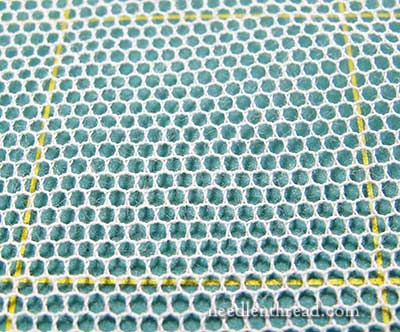
This is the tulle that I used, up close, situated over a one inch square on my cutting mat. It’s available at Lacis.
Before I go any further, I want to direct you to Susan Elliott’s blog, Plays with Needles, where she features an absolutely gorgeous piece of vintage tambour embroidery worked on tulle. That’s just so you know what can be done on good tulle!
And I should also add that good tulle is not inexpensive. The stuff above is 18 hpi (hexagons per inch). Lacis carries two types of tulle this gauge – one is $52 / yard and the other $75 / yard. Like I said, not inexpensive, especially when considering nylon tulle is pretty commonly available at craft and fabric stores for around $4 / yard (or less).
But good cotton tulle is much different from the nylon tulle sold at craft and fabric stores. The difference is in both the material it is made from and the structure. With cotton tulle, the interlocking cotton threads that make each hexagon create a strong (very strong) tulle suitable for all kinds of fine needlework techniques.
The inexpensive, widely-available nylon tulle on the market today does not stand up well to embroidery and other needlework techniques, and it is unpleasant to work with. It’s like working on wispy plastic – plastic that snags and tears very easily.
Most nylon tulle doesn’t work well under tension, either – it tends to tear in a hoop, or when tightening up a frame.
But cotton tulle is a strong net fabric. It’s a beautiful fabric. And it is a worthy ground fabric for the techniques of hand embroidery and lace worked on machine-made net.
All that having been said, I’m not advising you to invest in good cotton tulle for practicing tambour work! You can use any fabric – even $1.99 / yard muslin (or calico) to practice. Save the good fabric for your masterpiece, once you have the technique down.
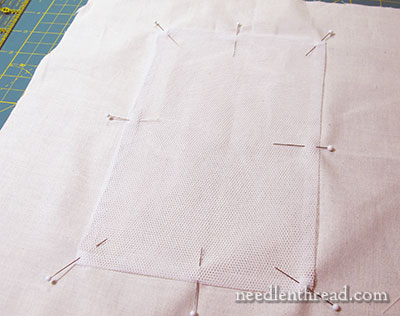
I bought this cotton tulle when I visited Lacis several years ago. I only have a couple little pieces left. To use these pieces, I have to enlarge them a bit so that they fit in a hoop or on a frame.
To enlarge a piece of good fabric, I always use an inexpensive fabric (usually a cotton muslin), cut to the size I need for the frame or hoop.
Here’s how I enlarged the tulle:
Folding the edges of the tulle in about 1/4″, I situated the tulle in the middle of the muslin and pinned it all the way around.
A short stint at the sewing machine with a zig-zag stitch or an overlock stitch or a couple lines of regular straight stitch all around the square of tulle (through both layers on the turned-under edge), and the tulle was fixed to the muslin.
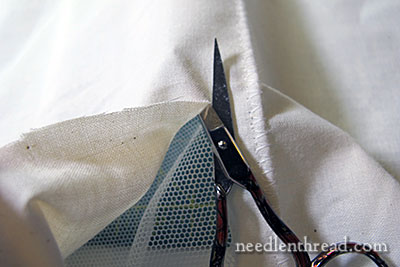
Then, I turned the fabric over so the muslin was uppermost, and pinched the muslin to separate it from the tulle. Carefully, with a pair of small scissors, I cut away the muslin from behind the tulle, right next to the sewn line.
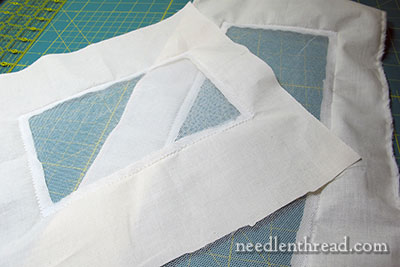
This resulted in several scraps of tulle that were now large enough to fit in a hoop or on a frame.
You can enlarge any type of fabric this way so that it fits in a hoop or frame. You can also sew strips of muslin around the perimeter to enlarge the fabric (though with tulle, it’s easier to do it this way, with the whole piece of fabric behind the tulle). So if you ever have a leftover wee scrap of your favorite linen or silk or velvet that you want to frame up, but it’s too small for a frame, enlarge it with an inexpensive but sturdy fabric.
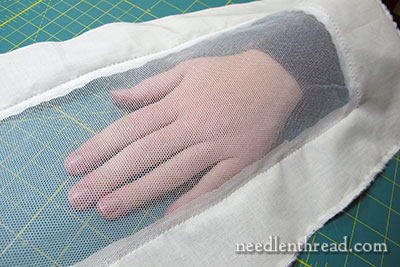
The tulle worked well as a relatively see-through fabric for demonstrating tambour work on. And, because it’s such a sturdy fabric, I was able to pick out all the demo stitches, and I still have a nice piece of good tulle to use later, for further demonstration. And when that’s done, I can pick out those demo stitches, and use the piece of tulle as a ground fabric for a little project.
I did, incidentally, try to use the cheaper nylon tulle from the local fabric shop for the demonstration. It was a disaster! It tore to shreds in the hoop, even with reinforcing fabric around the hoop to soften the contact; it snagged and ripped on the tambour needle at every given opportunity. And it simply wasn’t worth the $4 / yard I paid for it for this purpose. My level of frustration high, I turned to my hoarded scraps of cotton tulle, and was much happier for it!
Yep, the right materials make all the difference!







Thank you for another great lesson….
I like the look of and usage of cotton tulle. Very nice article.
Dear Mary
It looks a lovely fabric if you are embroidering something special then it’s worth paying for good fabric. I looked on Susan Elliott’s site what a beautiful Tambour design imagine how long that took to embroider lovely. Thanks for showing us how to enlarge the Tulle fabric a very useful technique, I would love to embroider with this fabric perhaps I might treat myself for Christmas you never know!
Regards Anita Simmance
Cotton tulle is a main ingredient in Princess lace, too! It comes in different “gauges” — holes per inch. One thing I have learned, is that the smaller the gauge (more holes per inch), the less “netty” it looks and you get more reflection off it with a moire-type effect. I personally like the larger-holed netting (usually less expensive, as well!!) because the things you apply to it appear more to be floating. It is interesting stuff to work with and can sometimes be found at a good fabric shop that does “bridal”. Still expensive… (There is also a silk tulle — but it is VERY soft and drapey and probably doesn’t have enough body for applied needlework.)
i’m wondering if i can make that cotton tulle. i do bobbin lace work. will have to look into that. are you familiar with the method that it is made?
Hi, Deanna – No, I’m not familiar with how it is made – it’s a machine-made net, though, I do know that. I’m thinking the twist is a lot like the ground for Mechlin lace, but maybe not as heavy? There certainly aren’t as many twists in the cotton tulle as there are in the ground worked for Mechlin lace, but it seems like the same principle. I don’t know enough about bobbin lace, though, to answer with certitude. If there are other lace makers out there, perhaps they could chime in! ~MC
Mary,
Is this cotton tulle the same thing as English netting? Martha Pullen has this at her store website for $30 a yd… 45″ wide… and she uses it and sells it for machine embroidery. She has worn embroidered jackets made from this stuff. And I’ve seen baptismal gowns and other “heirloom” dresses made using it as an overskirt that has been embroidered. I’ve long wanted to try the Irish and French laces using the tambour “hooking” technique and wondered just what was used as the backing net.
I share your disgust of nylon netting which I think is good for only cheap kid’s ballerina costumes and petticoats. I know some people use it for veils, but I prefer the real thing… illusion veiling (I happen to be making a wedding veil using illusion and French Alencon lace edging that I’m beading up with pearls and crystals).
Tess
Martha Pullen’s English netting is not quite the same stuff, I’m sure. It’s cotton, but apparently the hexagons are extremely tiny. I wrote to Martha Pullen company to ask some questions about their netting, including an approximate number of hexagons per inch, and this was their reply:
******
Thank you so much for your inquiry. Please note the Cotton English Netting is a tiny hexagonal shape. Unfortunately, they are too tiny to count.
I’m sorry if this has inconvenienced you.
******
I’m pretty sure if they went to the trouble to look at it, they could count how many hexagons per inch. It would be nice to know the gauge before purchasing it.
In any case, they’re out of white now, and their black and ivory are both on sale this week for almost half off.
~MC
Mary, from one teacher (retired) to another, my greatest compliment is that I learn so much from you. This is another great post.
I know exactly what I’ll be asking for as a Christmas gift. Meanwhile, muslin it is for practicing.
Thank you for explaining the difference between the good tulle and the fabric store variety. I’ve been so tempted to buy the stuff from the store and play with it, wanting to try stitching whatever I can. Now I know not to waste my money. So sad to hear that the nylon variety tears so easily. The type I’ve seen also doesn’t seem to be very consistent in mesh size or square. That’s why I keep putting it off. Always learning new things from you.
Mary, thank you for the above discussion. I was on the point of zipping over to Hancock’s to get some nylon netting so I could see the stitches forming. Funnily enough, I was in Lacis yesterday for the first time where I bought some tambour tools to try. Had I known about cotton tulle, I would have bought a quarter of a yard to try. I am moving to AZ soon and will certainly miss Lacis and Needle in a Haystack but fortunately, I am blessed with friends and family in the area so will be able to visit. Lacis was certainly an Aladdin’s cave of delights with beautiful threads, many tools, and some beautiful frames. So worth a visit, best, Charlotte
Yes, I agree with you. The right material makes the difference !
G’day Mary,
Thanks for this and previous related posts. I’ve always been interested in tambour work, there’s kind of little bit of magic intertwining it. The tulle lesson is of real interest. And, that circular table topper on Plays with Needles, oohhhh, how delightfully…umm…magical.
Cheers, Kath.
Thank you for this article Mary. I am trying very hard to avoid the , but I do have a hankering to try embroidering my own – I guess you would call it lace – designs, and I think tulle/net would be best for the base. The difference between the various fibres has never entered my head, so big thanks are due for this one.
Hello Mary,
I like your technique of enlarging ground fabric to fit a frame. Since I don’t have a sewing machine, what type of hand sewn stitches do you suggest to use as a substitute to attache the smaller fabric to the muslin?
Thanks for the information. I’ve been wondering about how to do this for a long time!
Herringbone stitch! I use it when hand stitching for stuff like this…
i did order some of the cotton netting from Martha Pullen at $15 a yard and it measures 20 hexagons per inch. i’m thinking it will work. it seems a good quality. here’s the link if anyone is interested. they were out of white so i ordered the ivory:
http://store.marthapullen.com/english-netting-ivory
Being redundant here in my comments, I just wanted to point out to anyone who is interested in cotton tulle that it is available online and by phone order from Mood fabric store in NY City in white, ivory and beige. It is $40 a yard. I am a professional tambour embroiderer and with my beginner students I use silk organza in sheer white for learning couture embroidery. It can be lashed to the proper drum taut tension with a slate frame, pinned to the top and bottom runner bars with long dressmaker pins to the stapled on twill tape, and laced to the side bars with pinned twill tape. For students of tambour lace, I use cotton tulle, although tulle can be used with couture embroidery as well, it just cannot be laced up as tightly. Very soon I plan to put a youtube tutorial link to my blog showing on film the framing up process. Thanks again!! All the best…
Are you able to tell me how cotton tulle behaves as a wedding veil? I am hoping o make one, edged with bobbin lace and I am wondering if I should be looking at cotton tulle for the fabric?
Should netting be washed before making a Christening gown?
Hi, Michelle – if you plan on regular laundering for the gown, and the tulle is cotton, I would. But if it is a synthetic, it may not be necessary. I’d test washing a piece and see if it shrinks and what happens to it in general when it’s washed.
Martha Pullen http://store.marthapullen.com/english-netting-ivory and Michael Levine http://www.lowpricefabric.com/p-1396-english-netting-ml12800.aspx
Both carry cotton english netting. I’m not sure of the hpi as yet, but at $30-$32 per yard, it is a good deal less expensive than Lacis. Try heirloom sewing suppliers.
Can you tell me where I can buy real English net to make my wedding veil with? I detest the nylon net veils sold at most bridal stores and the fabrics made of plastic sold at my local fabric stores. I would love to find silk tulle, but haven’t found any wide enough yet. Any help you can provide would be wonderful!
Hi, Christy-Lee – you can find silk tulle and English net at http://www.lacis.com – just go to their catalog and search tulle, and both should come up. Hope that helps!
Thank you Mary. I’m very new to needlework (have just begun trying some embroidery/boro/mending so I can salvage some sentimental clothing items)… I don’t know ANYTHING about sewing or needlework, so your tips are very helpful. I found this article while trying to figure out how to use some small fabric scraps (I thought I’d need to buy miniature hoops…). Thanks!
Love your website! As an American Revolution War reenactor, I find you historical techniques invaluable. Thank you.